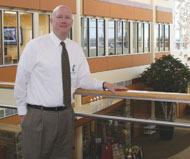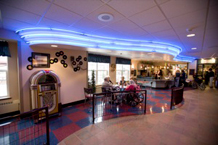
Perham Health in Perham, Minnesota, is a progressive provider of quality, personalized services committed to improving the health and well being for people of all ages. The 25-bed acute care hospital offers a full range of health care services with medical equipment that is technologically current, and a network of professional and qualified staff that is trained and skilled in each of their fields. A home-like environment is provided in the 96-bed skilled nursing facility where residents who are unable to live at home receive 24-hour nursing coverage.
Perham Health's New Hospital
The Perham Hospital District embarked on its most aggressive building project since the hospital was first established over 100 years ago. Construction of a new hospital and clinic began in Fall 2009. The new, state-of-the-art facility opened in January 2012 and will provide patients and their families the support and care they need in a comfortable healing environment.
The four overriding goals for the design included supporting:
- patient- and family-centered care;
- future growth;
- caregivers and providing for efficiency; and
- sustainability, commonly known as "building green."
Patient and family-centered care includes families as an equal part of the care team, and includes patients and families in the development of design, policies, and procedures from the very beginning. Perham included patients and family members on its design team. Staff, managers, board members, and community members toured multiple newly built or remodeled facilities across Minnesota, North Dakota, Wisconsin, Iowa, Montana, and Colorado. These tours were extremely helpful to the design process Perham gathered lots of helpful ideas and learned from other peoples' mistakes.
In addition to energy efficiency, the hospital now brings as much nature into the building through natural light, wood, water, and vegetation, as possible. Research proved that many commercial grade building products such as floor covering, wall covering, and other material contain PVC, which emits harmful volatile organic compounds into the air and compromises indoor air quality. Perham carefully selected products for the new hospital that are environmentally friendly and will not negatively impact indoor air quality, offering a healthy environment for patients, families, and employees.
Most of the efforts to date have been around changing hospital operations, such as nurses giving report about a patient's condition at the bedside and including the patient and family in this discussion.
Perham leadership included patients and families in the design and asked what kinds of things would help support this model of care. They added a number of things such as family rooms, private consultation rooms, a family resource center, a family kitchen, a meditation chapel, and outdoor garden areas close to the patient unit. They expanded the size of the patient rooms to have a dedicated space for families that includes a fold-out couch, recliner, and space for families to keep their personal items. Some unique art features and design elements have been incorporated into the building to help families get a mental break from the anxiety of caring for a family member. As each and every space was planned and designed, Perham asked patients and families how things would work for them and what they felt was important.
Perham Living: The Nursing Home
In 2001, with 56% more revenue than the year before, and $400,000 in new equipment—including an in-house CT scan, and mobile Magnetic Resonance Imaging (MRI)—Perham Memorial poised itself to continue to meet the health care needs of the area as the new century unfolded, by building a new nursing home.
Perham Memorial Hospital and Home celebrated a public grand opening of its new nursing home on Saturday, October 7, 2006, culminating a three-year, $14 million construction project and a transformation in resident care that gained the Perham facility national attention.
But before constructing a new model of an old fashioned building, the CEO, Chuck Hofius, and the Director of Nursing Marilyn Oelfke asked each other this question, "Would you want to live here?" And the answer, despite reported high patient satisfaction and low staff turn over rates in the existing nursing home, was a resounding "NO!"
Construction was put on hold temporarily and a series of community forums were held. The community was asked, "If you were going to live in a nursing home what would you want?" and "What does home mean to you?"
The answers:
- Life's simple pleasures, like a cup of coffee when I want it;
- Grandchildren, pets, children, guests, visitors;
- Four-season porches;
- Making cookies; sitting around the kitchen table, playing games, and laughing;
- Taking my medications on my own schedule; and
- Sleeping until I want to wake up.
Developing a New Model of Care—The Pilot
After hearing over and over, that the building is not the issue—attitude is the issue, the administration and staff decided to build a new model of care in the old building. They wanted to oust rigidity and schedules; they wanted EVERYONE cross-trained. Everyone was scared—could this work? After two years of talking and planning, a group of patients, staff, and the administration began a six-month pilot project by converting one 32-person unit into two "households" of 16 residents and assigning a permanent team of universally trained workers in each house. Each direct care employee was cross-trained and became responsible for housekeeping, laundry, dietary, and social activities. Each resident decided what time to get up in the morning. An open breakfast was available until 10 a.m. permitting residents a choice of when and what to eat. Bathing schedules were adapted to the residents' needs and desires rather than having a preset schedule.
Staff members managed their own work schedules, covering all shifts, weekends, and holidays. No one rotated to a new unit to care for people they didn't know and who didn't know them.
Response to Change
Amazing things began to happen. Although studies show that a significant percentage of nursing home residents are malnourished, sixty-six percent of the Perham residents gained weight. The number of folks suffering falls plummeted. Call lights are answered faster than ever because all staff is trained to respond to the residents' needs and the use of call lights shrunk to near zero.
Staff adapted to the residents' routines, providing them with the support they needed to continue to live their lives as they choose - a move away from the traditional medical model of residents adapting to the staff's routine to one that honors the residents' life-long routines. Even though the members of the staff have taken on many new duties as universal workers, they have more time to spend with the residents. The workload is evenly distributed throughout the day with everyone working together to see that everything gets done.
The "New" Perham Nursing Home
Immediately following the change to this new model of care, staff turnover increased. The former "shining stars"—those staff members who focused on routine and task completion—had difficulty letting the residents set their own care agenda. Some Licensed Practical and Registered Nurses felt "demoted" by having to do laundry and other "non-nursing" duties. Many resigned to return to work in nursing homes where tradition reigns.
In the new building, there is no nursing station, no "Medication Room," and no medication times! Residents take their medications as prescribed, such as after meals, or before bed, just like when living in their own home. And since each staff member can do all tasks, residents are free to wake up, eat breakfast and other meals, and go to sleep when they want to. Physicians are thrilled with the change because their patients and their families are happy and they are receiving fewer phone calls complaining about care.
Building on lessons learned during the pilot, the new facility consists of "neighborhoods." Each household is home to 16 residents and has a country kitchen, living room, dining room, and porch. Most resident rooms are private. At the Town Center, residents can come together with the larger community to enjoy a movie at the theatre, shop at the General Store, go to church, have a haircut, and enjoy activities with children in the Schoolhouse.
Perham Memorial Nursing Home has been lauded as a pioneer for what is known in the industry as Culture Change. The nursing home was featured on the cover of Culture Change Now! and in the March 2004 and March 2006 issues of DESIGN. A number of state and national conferences have invited the leadership of Perham to speak about this innovative model of care. In addition, personnel from nursing homes across the state and country are visiting the Perham facility to experience first hand this groundbreaking way to care for residents.
Chuck Hofius, CEO of Perham, was selected as the 2006 Administrator of the Year by the Minnesota Hospital and Home Association. He was recognized at their conference in February, 2007.





